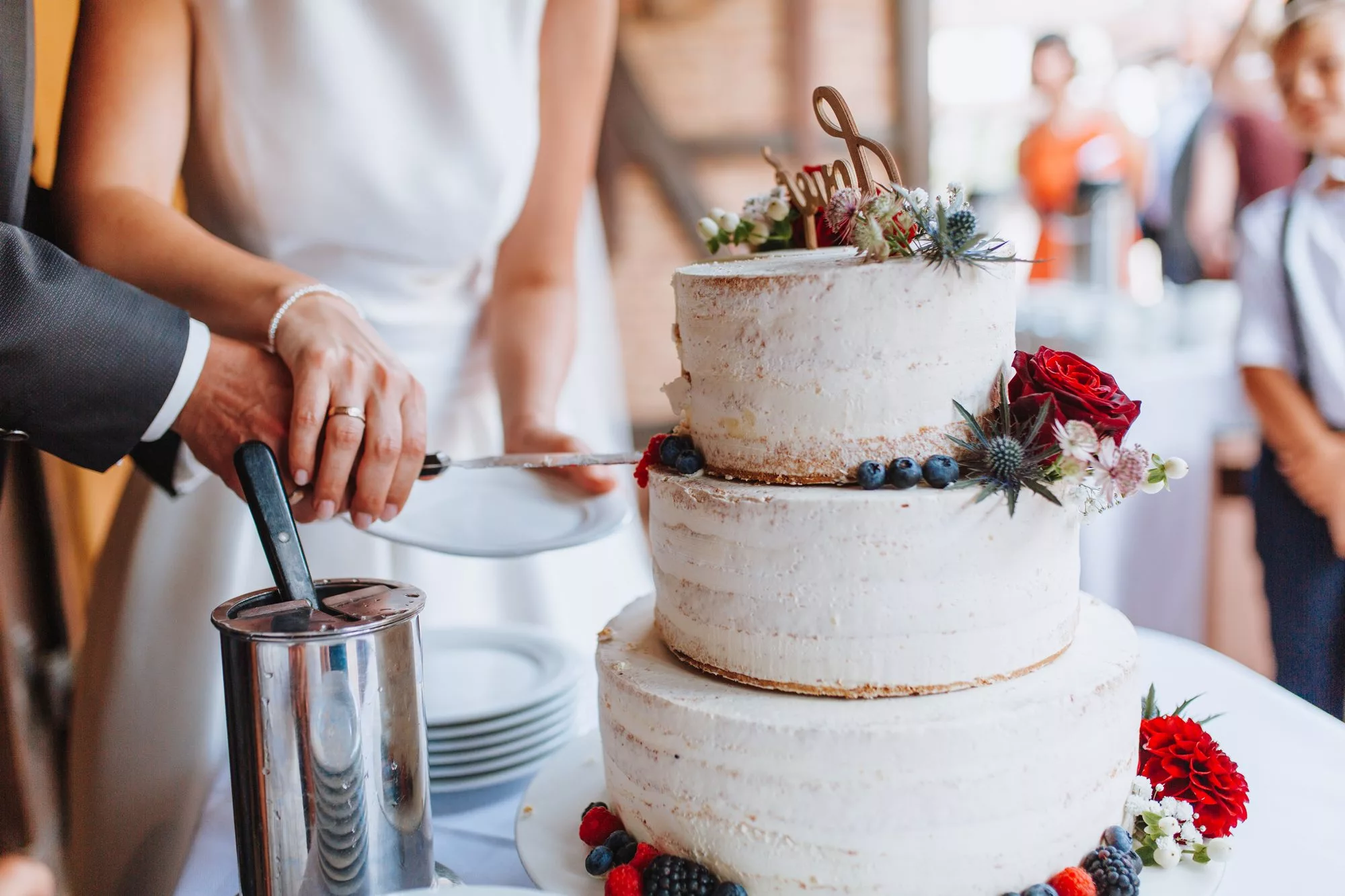Tradition plays a big role in many weddings. A traditional wedding cake is one such example, symbolizing a couple’s newly established partnership and helping to celebrate that commitment with wedding guests. Wedding cakes look great too, and express the beauty of this shared tradition.
Throughout the wedding planning process, you’ll have opportunities to opt for a more traditional affair or something more modern. Don’t fret, you can easily blend the two; even updated weddings can still include a traditional cake. Let Frost Artisan Bakery help you design your dream wedding cake (traditional or modern). In the meantime, explore these time-tested wedding cake traditions that can make your wedding special.
Wedding Cake Traditions
1. Cutting the cake: The cutting of the cake is a time-honored tradition. It was first introduced as a symbol of unity and shared responsibility that marked the first act of overcoming life’s challenges together. Usually, this brief ceremony is performed when the married couple clasps their hands together to slice the first piece of cake as a single pair. And while you’ll undoubtedly be focused on sharing this moment with your new spouse, wedding guests will have the opportunity to witness this act of unity and marital strength.
The cake cutting is traditionally done at the end of the reception and signals guests that they can begin to leave. Today, weddings typically run late into the evening and while we don’t recommend waiting until the wee hours, we do suggest you take a moment to pose with your spouse beside a stunning cake to honor the special occasion. You’ll always enjoy looking back at this particular photo.
The cake-cutting ceremony symbolizing happiness and prosperity has existed in one form or another since ancient Rome. However, the wedding cake as we know it hasn’t always been the elegant, tiered structure of flour and frosting we know today. Back then, a loaf of bread would be broken over the couple’s head in a similar vein to today’s cake cutting. Between the 17th and 19th centuries, Victorian cakes resembled a dish similar to the modern shepherd’s or pot pie, filled with meat and vegetables, instead of layers of ornate frosting. We’re glad this tradition went by the wayside.
2. Three layers: The traditional wedding cake has three tiers smaller in circumference with each additional layer. The convention states that the three levels represent the tenants of prosperity, good luck, and fertility. The bottom layer is cut the night of the wedding, distributed to guests, and typically enjoyed together. The middle and top tiers are packaged and stored (often frozen) for one year. The couple thaws and cuts the middle tier, usually within the comfort of their home, to acknowledge their first year married together. Finally, the third tier expresses fertility, particularly among couples who go on to give their first child a Christian baptism.
3. Fruit toppings: Fruit doesn’t just add color to your wedding cake, it also signifies luck, prosperity, and fertility for the happy couple. Fruit can be used to add pizzaz as a garnish or can be integrated into the cake itself for flavor. Fruits also help preserve the cake and keep them moist longer. Traditionally, a married couple eats their last slices of wedding cake after their first child’s christening.
4. Sending a slice home: Cakes were not always served as dessert at weddings. Instead of a slice to be eaten at the wedding’s reception, the cake was once considered more a party favor to be sent home with guests. Traditionally, single guests would place the cake under their pillow while they sleep to inspire sweet dreams about their future partners. There are still some who believe that just the act of taking a cake home helps to bring about good romantic fortune in any person’s life.
5. Smashing cake into faces: The meaning of this messy ritual has changed over the years and opinions on its merits vary. Many believe cake smashing stems from the ancient Roman tradition of breaking bread over the bride’s head, however, some question these antiquated origins. In modern times, the smashing of cake can be a moment of levity and a great memory to share with one’s partner, if they are comfortable with it.
Despite the tradition’s exclusion from some modern weddings, the practice is still immensely popular. The TikTok hashtag #cakesmash and other similar tags earn millions of views per year. Ultimately, whether you and your partner decide to include a cake-smashing moment, either due to its traditional meaning of good luck or as a playful exchange between the spouses marking the last leg of their wedding celebration, should be up to you.
6. Cake pulls: Also known as cake charms, a cake pull is a Southern US convention with roots in the Victorian Era. It is a simple but fun activity performed by bridesmaids, friends, or anyone else who wants to join in the fun. Guests pull on a piece of ribbon or string of pearls attached to a small metal charm tucked between the layers of the wedding cake. The charms are made of food-safe material in simple, recognizable designs that are said to indicate the participant’s future.
Traditional charms have established meanings that range from obvious (baby shoes = upcoming pregnancy), to fun (alligator = you’ll live a long and enjoyable life), to fanciful (frog = you’ll meet your prince or princess soon), to hopeful (bird = a new opportunity will present itself). If you expect your wedding guests to be unfamiliar with this tradition, you can make a brief guide to what each charm means and make it available to guests at the wedding reception. Pull cakes usually contain eight charms but you can add as many or as few as you’d like!
7. Never refusing a slice of cake: This one’s for wedding guests. It’s a convention to always accept a slice of wedding cake when offered. To refuse is bad luck! With that in mind, make sure your wedding cake is something guests will enjoy! This can be more difficult than it sounds, especially for larger weddings. It can be hard to please everyone, and ultimately, the flavor and style of wedding cake should be based on what the happy couple wants.
There’s certainly a lot of options to choose from: Vegan and gluten-free cakes are now a viable option for many weddings and can be more inclusive of individuals’ preferences and dietary restrictions. But if these modified options don’t appeal to you, consider offering more than one dessert! That way guests can pick their favorites and enjoy the cake cutting ceremony with guests who do consume flour cake, even if they do not. Options include donuts, cookies, or a second, modified-ingredient cake. The skilled bakers and pastry chefs at Frost Artisan Bakery can help you plan a memorable and inclusive wedding dessert with multiple offerings, including constructing your perfect wedding cake.
Sweet Superstitions
In our wedding cake research, we came across a handful of superstitions related to cakes that we thought would be fun to share. These might be fun facts for bridal shower trivia!
- Sharing the cake with family and friends increases fertility and prosperity.
- The bride who bakes her own cake is asking for trouble.
- A taste of the cake before the wedding means the loss of a spouse’s love (while a piece of cake kept after the big day ensures his fidelity).
- At Queen Victoria’s wedding to Prince Albert in 1840, white icing was used to decorate her cake, establishing the tradition of “royal icing” on wedding cakes.
- In medieval England, small spiced buns were stacked as high as possible. If the bride and groom were able to kiss over the tall stack, it indicated a lifetime of prosperity.


